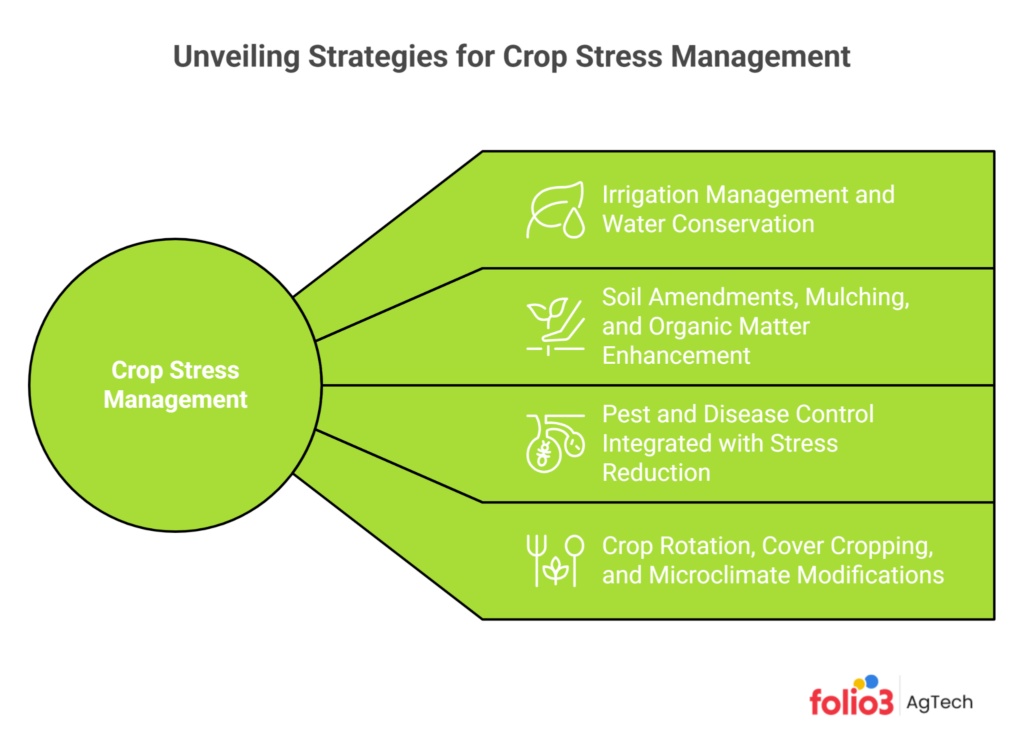Crop stress is a growing concern for modern agriculture, affecting plant growth, development, and yield potential. Abiotic factors such as drought, heat, salinity, and nutrient imbalances create physiological stress that limits productivity. In fact, reviews estimate that abiotic stresses account for around half of all crop yield losses worldwide, highlighting the scale of the challenge that farmers face. Environmental variability, combined with soil health challenges, further amplifies crop vulnerability and can lead to uneven growth, reduced quality, and lower marketable output.
Beyond the biological impact, unmanaged crop stress carries a significant economic burden. Farmers may face increased input costs as they attempt to compensate for stressed plants, while yields and overall profitability decline. Understanding the causes, recognizing early indicators, and implementing targeted, actionable solutions are therefore critical. In this guide, readers will learn about the main stress factors affecting crops, how to detect them efficiently, and practical strategies to mitigate their impact for healthier, more resilient plants.
Environmental Crop Stress Factors
Environmental stress is one of the leading causes of reduced crop performance and yield variability in both open fields and controlled systems. From prolonged droughts to sudden frost events, these factors directly affect plant physiology, water balance, and nutrient uptake. Understanding how each type of environmental crop stress develops helps growers anticipate risks, apply targeted crop management practices, and protect overall productivity.
Heat, Drought, and Waterlogging
Extreme temperatures and irregular water availability are among the most common sources of crop stress. Heat waves can accelerate evapotranspiration, causing plants to wilt and reducing photosynthesis efficiency. Drought limits nutrient uptake and slows growth, while waterlogging deprives roots of oxygen, leading to root rot and stunted development. Effective crop management practices, including irrigation scheduling and soil moisture monitoring, help mitigate these stresses and reduce the risk of crop failure.
Temperature Fluctuations and Frost Risk
Sudden changes in temperature, especially cold snaps or unseasonal frost, can damage sensitive plant tissues, disrupt flowering, and reduce yield. Seedlings and young plants are particularly vulnerable. Protective strategies include using row covers, frost fans, or selecting tolerant varieties. Regular crop scouting allows farmers to detect early signs of temperature-induced stress and intervene before losses become severe.
Wind, Salinity, and UV Exposure
Strong winds can physically damage plants, increase transpiration, and strip protective leaf layers, while high salinity in soil or irrigation water creates osmotic stress that limits water uptake. Excessive UV exposure can degrade chlorophyll and reduce photosynthetic efficiency. Implementing windbreaks, soil amendments, and shade structures helps minimize these effects and ensures healthy growth under challenging conditions.
Biological Stress Factors
While environmental conditions set the stage for plant performance, biological stress often delivers the most direct damage to crops. These living stressors attack roots, stems, and leaves, disrupting normal growth and significantly lowering yields. Understanding how each biological factor contributes to overall crop stress allows growers to take timely and targeted action.
Pests, Insects, and Pathogen Pressure
Insect pests and pathogens are among the most destructive sources of crop stress. Aphids, whiteflies, and borers weaken plants by feeding on sap, while fungal, bacterial, and viral diseases destroy tissues and reduce photosynthetic capacity. Managing these threats requires integrated pest management, early disease scouting, and timely application of biological or chemical controls. Effective monitoring also helps prevent the spread of common crop diseases that can devastate entire fields.
Weed Competition and Growth Suppression
Weeds compete aggressively with crops for nutrients, light, and water, especially during early growth stages. This hidden form of crop field stress often results in lower biomass accumulation and poor seed development. Regular field scouting and strategic crop rotation are essential to minimizing weed pressure and maintaining balanced soil health.
Microbial Imbalances in Soil
A healthy soil microbiome supports nutrient cycling and root health. However, imbalances caused by overuse of fertilizers, pesticides, or monocropping can disrupt beneficial microbial activity, leading to nutrient lockup and weak root systems. Promoting microbial diversity through organic amendments, reduced tillage, and cover crops helps restore soil vitality and increase crop yield over time.
Nutritional and Soil-Related Stress
Nutritional and soil-based factors are often overlooked but play a major role in crop stress and overall plant performance. When soil health declines or nutrient balance is disrupted, crops lose their ability to absorb essential elements efficiently, resulting in stunted growth and uneven development. Consistent soil monitoring and targeted management are critical for avoiding these hidden yield losses often seen in crop field stress conditions.
Nutrient Deficiencies and Imbalances
Deficiencies in nitrogen, phosphorus, potassium, or micronutrients such as zinc and iron are among the most common forms of crop stress. When one nutrient is lacking or out of balance, plants divert energy from growth to survival, causing leaf chlorosis, poor root development, and delayed maturity. Regular soil testing and precision fertilization strategies help ensure optimal nutrient availability throughout the crop cycle.
Soil Compaction, pH, and Structure
Compacted or poorly structured soils restrict root penetration and reduce oxygen flow, while extreme soil pH, either acidic or alkaline, limits nutrient solubility. This combination can severely amplify crop stress by impeding water uptake and microbial activity. Incorporating organic matter and maintaining proper soil aeration can help restore balance and improve nutrient cycling.
Fertilization Errors and Over-Application
Over-application of fertilizers is another leading cause of crop stress, as it disrupts soil microbial communities and increases salinity levels. Excess salts can burn roots, hinder nutrient absorption, and degrade soil fertility over time. Smart nutrient scheduling and soil fertility management practices not only prevent these problems but also promote sustainable, long-term soil productivity.
Detecting and Monitoring Crop Stress
Early detection of crop stress can mean the difference between a manageable issue and a costly yield loss. Whether stress is caused by environmental, biological, or nutritional factors, understanding how to recognize warning signs and apply timely interventions is key to maintaining productivity. Combining visual assessments with technology-driven monitoring allows growers to make data-informed decisions and improve overall crop field stress management.
Visual Indicators in the Field
The first step in identifying crop stress is through close field observation. Key signs to look for include:
- Leaf discoloration: yellowing, purpling, or bronzing
- Wilting even when soil moisture is adequate
- Stunted or slowed growth
- Irregular canopy development or uneven plant height
- Leaf curling or deformation
- Premature leaf drop
- Uneven flowering or fruit set
These symptoms can indicate underlying issues such as nutrient imbalance, pest activity, or water deficiency. Trained scouts often record these signs manually while cross-referencing with previous growth data to detect early deviations.
Digital Tools and Data Monitoring
Modern agriculture uses digital tools to track and analyze crop stress in real time. Technologies like NDVI imaging, satellite data, and drone-based mapping help detect changes in canopy vigor and chlorophyll content before they become visible to the naked eye. Ground-based sensors measure soil moisture, temperature, and nutrient levels, providing continuous feedback that guides irrigation and fertilization schedules. Integrating these systems supports smart harvest planning by identifying which zones are underperforming and when corrective actions should be applied.
Sampling Frequency and Scouting Best Practices
Regular data collection ensures that crop stress is identified promptly. Scouting frequency should vary based on crop growth stage, environmental volatility, and field history. Using standardized sampling grids and maintaining consistent observation records make comparisons easier across seasons. Combining human observation with sensor data provides a comprehensive stress profile, ensuring that interventions are both targeted and effective in sustaining healthy crop performance.
Proven Solutions to Manage Crop Stress
Reducing crop stress requires a proactive and balanced approach that considers water management, soil health, pest control, and environmental adjustments. Each factor contributes to stabilizing plant physiology and improving resilience against external pressures. By integrating best practices across these areas, growers can prevent crop field stress from escalating into major yield losses.

Irrigation Management and Water Conservation
Water stress, whether from drought or excess moisture, is among the most common causes of crop stress. Precision irrigation systems such as drip and sprinkler setups help deliver water efficiently to the root zone while minimizing evaporation. Scheduling irrigation based on soil moisture data and weather forecasts ensures that crops receive the right amount of water at the right time. Techniques like deficit irrigation can also strengthen plants by improving their drought tolerance. Incorporating water conservation strategies, including the use of rainwater harvesting and greywater recycling, further supports long-term sustainability.
Soil Amendments, Mulching, and Organic Matter Enhancement
Healthy soil is a key defense against crop stress. Regular incorporation of compost, biochar, or well-decomposed manure improves soil structure, enhances nutrient availability, and boosts microbial activity. Mulching with organic materials such as straw or leaf litter helps retain soil moisture, reduce temperature fluctuations, and suppress weed growth. These amendments not only promote root health but also create a stable environment that buffers plants against climatic stressors.
Pest and Disease Control Integrated with Stress Reduction
Managing pests and diseases is essential for reducing crop stress. Infestations and infections divert plant energy away from growth and yield formation. Integrating organic pest control practices such as beneficial insects, pheromone traps, and biocontrol agents can keep populations in check without harming beneficial soil life. Disease management through resistant varieties, sanitation, and crop residue management further minimizes physiological stress and improves recovery capacity after outbreaks.
Crop Rotation, Cover Cropping, and Microclimate Modifications
Rotating crops with different rooting patterns and nutrient demands breaks pest and disease cycles while restoring soil fertility. Cover crops like legumes and clover protect against erosion, improve nitrogen levels, and enhance soil texture. Adjusting the field microclimate through windbreaks, shading structures, and proper spacing helps regulate temperature and humidity, critical factors in managing crop stress. These combined practices build long-term resilience, ensuring that crops can thrive even under fluctuating environmental conditions.
By aligning irrigation efficiency, soil health, and biological control, growers establish a comprehensive system that supports steady yields and sustainable field performance across growing seasons.
How AgTech Solutions Help Farmers Manage Crop Stress
Modern agriculture faces mounting challenges from environmental, biological, and nutritional stressors. Managing crop stress effectively requires timely data and actionable insights, which is where AgTech solutions play a critical role. Tools like Folio3 AgTech crop scouting software empower farmers to detect, monitor, and respond to stress factors before they escalate into major yield losses. By integrating field-level observations with digital analytics, growers gain a comprehensive view of plant health and environmental conditions, helping reduce crop field stress and improve overall productivity.
Key Features:
- Real-Time Stress Detection
- Environmental Sensor Integration
- Predictive Analytics
- Automated Alerts and Recommendations
- Data-Driven Intervention Records
These features enable continuous monitoring of crops, allowing farmers to identify early warning signs of water deficit, nutrient imbalance, pest pressure, or disease outbreaks. Predictive analytics help forecast potential stress events, while automated alerts ensure timely interventions. Integration with sensors and IoT devices provides granular, location-specific data, reducing guesswork and supporting precision agriculture practices.
By leveraging Folio3 AgTech, growers can take a proactive approach to managing crop stress, implementing interventions that are informed by data rather than intuition. This leads to healthier crops, optimized input use, and enhanced field-level productivity. Ultimately, combining traditional agronomic knowledge with advanced technology ensures that crop stress is addressed efficiently, sustainably, and profitably across all types of farming systems.
Conclusion
Effectively managing crop stress is essential for maintaining healthy, high-yielding crops and ensuring farm profitability. Unchecked environmental, biological, or nutritional stress can rapidly reduce plant performance, leading to lower harvest quality and economic losses. Early identification, regular monitoring, and timely interventions are key to mitigating these impacts and sustaining long-term productivity.
Integrating traditional agronomic practices with modern technology provides a comprehensive solution. Techniques such as proper irrigation management, soil amendments, crop rotation, and pest control remain fundamental, but their effectiveness is greatly enhanced when combined with digital tools. AgTech platforms like Folio3 AgTech Crop Scouting Software provide real-time monitoring, predictive analytics, and data-driven recommendations, allowing farmers to respond quickly to crop field stress before it escalates.
FAQs
What is crop water stress?
Crop water stress occurs when plants do not receive adequate water to maintain normal physiological functions. Symptoms include wilting, leaf curling, reduced growth, and lower yield. Managing irrigation efficiently and monitoring soil moisture are key to preventing water stress in crops.
What does plant stress look like?
Plant stress can manifest in various ways depending on the type of stress. Common signs include yellowing or browning leaves, stunted growth, leaf drop, wilting, poor flowering, or abnormal fruiting. Visual monitoring combined with digital tools can help identify stress early and prevent crop losses.
What does crop resilience mean?
Crop resilience refers to a plant’s ability to withstand or recover from adverse conditions such as drought, pests, diseases, or extreme temperatures. Resilient crops maintain productivity despite stress factors, often aided by genetics, soil health, and proper management practices.
Is super cropping high stress?
Yes, super cropping is a high-stress training technique used mainly in horticulture to increase yields. It involves bending and slightly damaging stems to improve light penetration and airflow. While it can boost productivity, it must be managed carefully to avoid excessive stress that could harm plant health.






